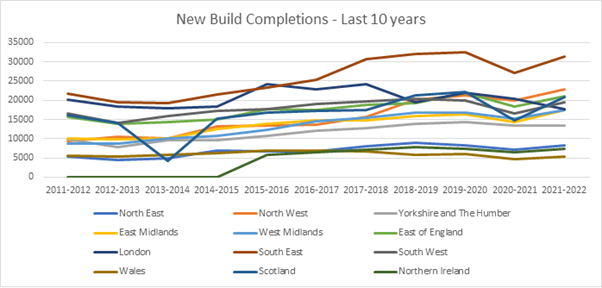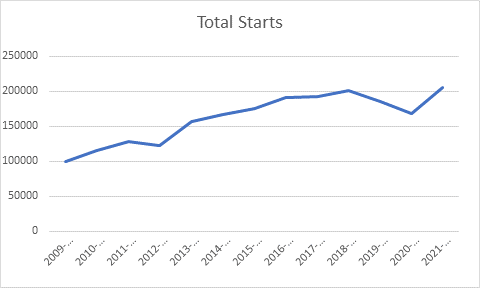Geodesys: New-build – are there reasons to be positive?
Jonny Davey, Head of Product and Business Development at Geodesys, has written an article called New-build – Are there reasons to be positive?
London and the South East consistently make up a quarter of all new-build completions according to Office for National Statistics data.
The statistics, which cover England, Wales, Scotland and Northern Ireland identify that just over 26% of all new-build housing completions have been recorded in the London and South East Regions, hitting just 29% in 2017/18.
The numbers are in stark contrast to the North East (4%) and Yorkshire and the Humber (7%). In the Midlands, the combined completion numbers across West and East Midlands accounted for 16% of all completions.
Successive governments have pledged to place home-building at the centre of their manifestos. In 2017 the then-Chancellor Philip Hammond committed the current Conservative government to build an additional 300,000 homes a year by the mid-2020s. However in December 2022, the mandated numbers became “advisory” in a statement from Department of Levelling Up, Housing and Communities (DLUHC) head Michael Gove, ahead of the Levelling Up and Regeneration Bill.
In what was widely considered a U-turn in response to rebellious backbenchers, Mr. Gove said:
“If we are to deliver the new homes this country needs, new development must have the support of local communities.
“That requires people to know it will be beautiful, accompanied by the right infrastructure, approved democratically, that it will enhance the environment and create proper neighbourhoods.
“These principles have always been key to our reforms and we are now going further by strengthening our commitment to build the right homes in the right places and put local people at the heart of decision-making.”
Planning reform has long been mooted as a key blocker to housing developments. In 2012 the coalition government led by David Cameron introduced the controversial National Planning Policy Framework (NPPF), reforming the archaic and obstructive planning system with a new directive to “approach decisions on proposed development in a positive and creative way.”
In an effort to simplify the planning process the instruction from the Government was clear:
“Decision-makers at every level should seek to approve applications for sustainable development where possible.”
In the iterations since, the NPPF has enshrined this mantra.
More recent planning proposals have stalled. The “largest shake-up of planning for a generation” proposed in the Queen’s speech ahead of the opening of Parliament in 2021 was quietly scrapped just months later following heavy losses at local by-elections.
The Levelling-up and Regeneration Bill is working its way through Parliament and is currently at Committee Stage in the House of Lords. With some of the previous proposals now watered down or removed, the bill proposes to simplify planning further and create a more digitised process, introduce a new Infrastructure Levy which will enable local authorities to retain income from releasing land for development and redistribute it locally, introduce neighbourhood plans which could enable local vetoes, and penalise slow developers on land already approved for homes.
One of the key challenges for conveyancers when it comes to new-builds is the availability of helpful and reliable data. Drainage and water supply data, a key consideration, can be hit and miss and traditional CON29DW reports in particular can provide a raft of irrelevant and unhelpful information. Questions like whether the property is at risk of internal flooding due to overloaded public sewers cannot be ascertained given newly-built property will not be on any “internal flood risk” register.
A reduced, simplified NewBuildDW available exclusively from Geodesys in the East Anglia region provides all the requisite supply data found in the CON29DW and merges some other questions, such as those about charging, to provide conveyancers with a more streamlined report which ultimately takes less analysis and often raises fewer enquiries.
Despite the failure to hit targets, there is some positivity in the ONS figures. Following near 10% falls in new development starts in 2019/20 and 2020/21 amid the COVID-19 pandemic, the numbers have recovered in 2021/22 to their highest level in a decade; 205,000 new-build homes, a 60% increase on 10 years ago. And while completions haven’t yet hit the numbers achieved pre-pandemic, a 46% increase on 10 years ago would indicate that we’re moving in the right direction.
Kindly shared by Geodesys
Main picture courtesy of Pixabay




















